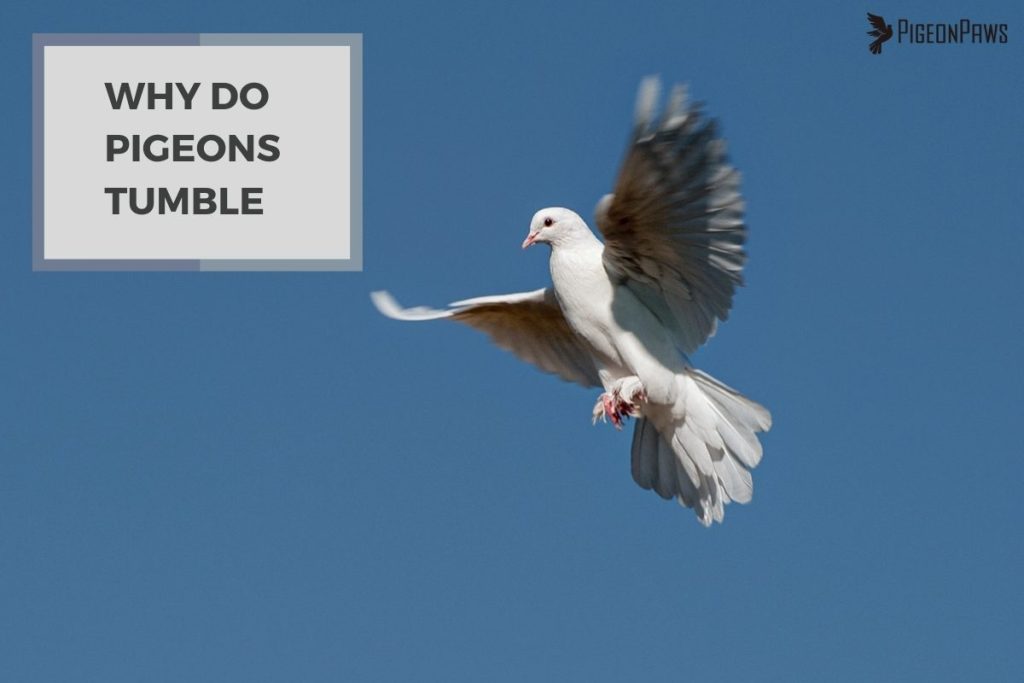Why Do Pigeons Tumble? Reasons Explained

Pigeons are fascinating creatures that are often seen in urban areas, cooing and pecking at crumbs on the sidewalk. One of the most curious behaviors of pigeons is their tendency to tumble or somersault in mid-air. This behavior is not only intriguing to observe but has also sparked the curiosity of scientists and bird enthusiasts alike.
Scientist believes that the presence of the “RO” gene in pigeons’ DNA naturally leads pigeons to tumble in the air when flying or even on the ground. So it’s a genetic behavior that pigeons use to do it for fun, express excitement, and even escape from flying predators such as falcons.
Let’s take a closer look at the tumbling habit in pigeons, the impact of this fascinating behavior, and more.

Why Do Pigeons Tumble? Explained In Details
Scientists and experts have put forward a few different explanations when it comes to understanding why pigeons tumble or somersault. Here’s what we know about their somersaulting antics:
Survival Mechanism
When it comes to survival, pigeons are no slackers! Scientists believe that performing somersaults mid-flight is actually a survival tool. It allows them to quickly dodge any predators that may be lurking in the sky. This gives them a chance to get away unscathed and continue their journey.
Show Of Affection
Another theory is that it is done to show affection. When a male pigeon is trying to woo a female, he may show off his skills by performing somersaults in the air. It is a way for him to demonstrate his agility and strength, which can be a major factor in attracting a mate.
Genetic Trait
Some experts also believe that somersaults are actually a genetic trait. It is something that is passed down from parent to offspring, so it is seen in multiple generations of pigeons. This could explain why some of the birds have a tendency to perform maneuvers more often than others.
Playful Behavior
Many experts claim that tumbling is simply a playful behavior that pigeons engage in for fun or to express excitement. It is a way for them to show off their agility and have a good time.
Ultimately, the cause of pigeons’ somersaults is still up for debate. But one thing is for sure – it is a sight to behold!
The Effects of Tumbling on Pigeon Health
Pigeons are known for their acrobatic tumbling abilities, but have you ever wondered if this behavior is harmful to their health? The answer is it can be.
When a pigeon takes off and immediately starts tumbling, it can crash and hurt itself. And not all pigeons are created equal when it comes to tumbling. Some may not have as much control over their tumbling and can hit the ground, which can lead to injury or even death.
But before you start feeling bad for these acrobatic birds, it’s worth noting that tumbling can actually have some benefits for a pigeon’s health. Tumbling requires the bird to use its muscles and coordination in unique ways that it may not during normal flight, which can improve its physical fitness.
So, next time you see a pigeon somersaulting through the sky, you can appreciate the beauty of its acrobatics, but also keep in mind that it’s not without its risks. But don’t worry. These birds have been doing it for centuries, and they know what they’re doing.
Is Tumbling A Learned Behavior In Pigeons?
The short answer is it’s a little bit of both. Tumbling is primarily a genetic trait passed down from generation to generation.
It’s like a talent that runs in the family, but as with any skill, practice makes perfect. Through observation and experience, pigeons can learn to tumble more gracefully and accurately, and with time, this learned behavior can become instinctual.
Tumbling is a behavior that has been studied extensively in pigeons. Researchers have found that when young pigeons are exposed to older, more experienced tumblers, they’re more likely to learn the behavior.
This indicates that tumbling is, at least in part, a learned behavior. It also appears that tumbling is more a matter of practice than a genetic trait, as birds that tumble more often tend to improve their performance over time.
Can Pigeon Tumbling Lead to Aggressive Behavior Between Pigeons?
Can pigeon tumbling lead to aggressive behavior between pigeons? There are fascinating reasons for pigeon aggression. While pigeon tumbling is an instinctive behavior displayed during courtship or as a form of play, it can also be a trigger for aggression. In some cases, dominant pigeons may feel threatened by the tumbling behavior of others, leading to territorial disputes and potential aggressive interactions. Understanding these dynamics is essential to managing pigeon populations effectively.
Conclusion
Pigeon tumbling is a fascinating behavior that is still not fully understood. It can be triggered by a variety of factors, from the presence of a predator to a sudden gust of wind.
While it is not known how the birds learn this behavior, it is thought that it may be instinctual or learned behavior from their parents. Regardless of the cause, it is an amazing phenomenon that continues to fascinate bird watchers of all ages.

